Some blooms of my
collection #41 - Seeds Germination
Olá Amigos,
Hello Friends,
Gostaríamos de
compartilhar com vocês algumas informações que
achamos muito interessantes sobre a germinação de
sementes removendo e não removendo a casca.
Nós não tivemos tempo dedicado a realizar muitas
experiências, mas com o pouco que foi feito já dá
para ter uma boa noção do que pode acontecer com as
sementes que são plantadas sob a terra para germinarem.
Com este simples teste, para nós ficou muito clara a grande luta
realizada por cada semente para conseguir romper a casca e ter o
privilégio da vida. E para nós ficou também muito
claro por que a taxa de sucesso na germinação de sementes
pelo método convencional (em baixo da terra) é bem menor.
We would like to share with you some information that we find
very interesting about seeds germination by removing and not
removing the seed coat.
We do not have time dedicated to perform many experiments, but with
what little has been done already gives to have a good sense of what
might happen with the seeds that are planted in the earth to germinate.
With this simple test, for us is very clear the great struggle carried
out by each seed to breaking through the seed coat and to have the
privilege of the life. And for us is also very clear why the success
rate of seed germination by the conventional method (beneath the soil)
is much lower.
As protagonistas foram oito sementes do cruzamento da 128 Key West x 87 Silver Moon:
The protagonists were eight seeds from the cross of the 128 Key West x 87 Silver Moon:
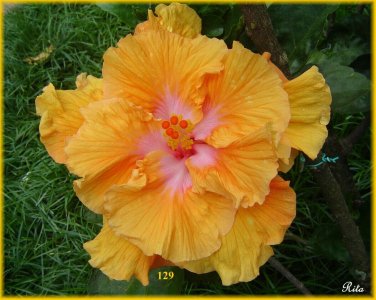
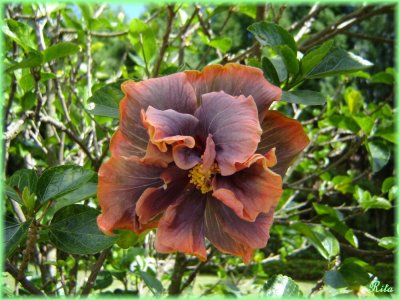 Dia
1 – As 8 sementes foram escarificadas (nikadas) e colocadas em um
pequeno container com algodão úmido (com tampa).
Dia
1 – As 8 sementes foram escarificadas (nikadas) e colocadas em um
pequeno container com algodão úmido (com tampa).
Dia 3 – Nas 4 sementes da esquerda (algodão azul) a casca
foi removida com as mãos no Dia 2, após ficarem inchadas.
As 4 sementes da direita (algodão rosa) permaneceram com a casca.
Day 1 – The 8 seeds were scarified (nicked) and placed in a small container with moist cotton (with cover).
Day 3 - In the four seeds on the left side (blue cotton) the seed coat was
removed with the hands on Day 2, after being swollen. The four seeds on
the right side (pink cotton) continued with the seed coats.
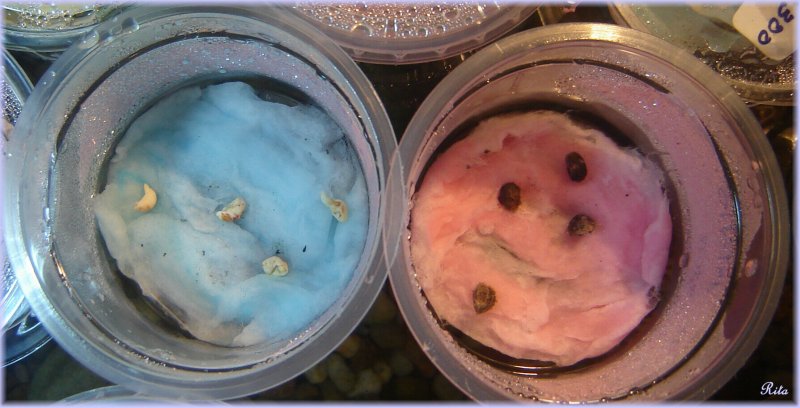
Dia 6 – As quatro sementes sem a casca já estão se desenvolvendo.
Day 6 – The four seeds without the seed coat are already developing.
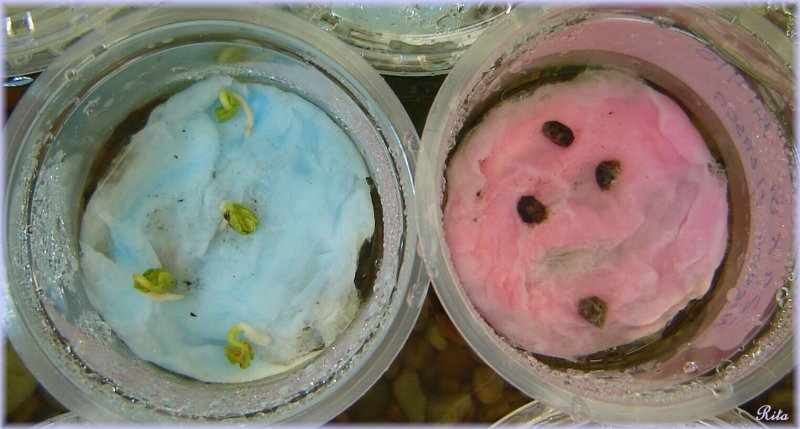
Dia 7 – Idem
Day 7 – Ditto
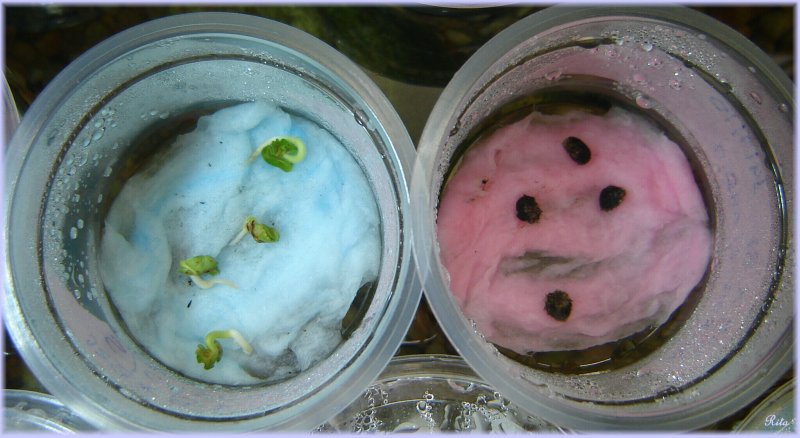
Dia 8 – Idem
Day 8 – Ditto
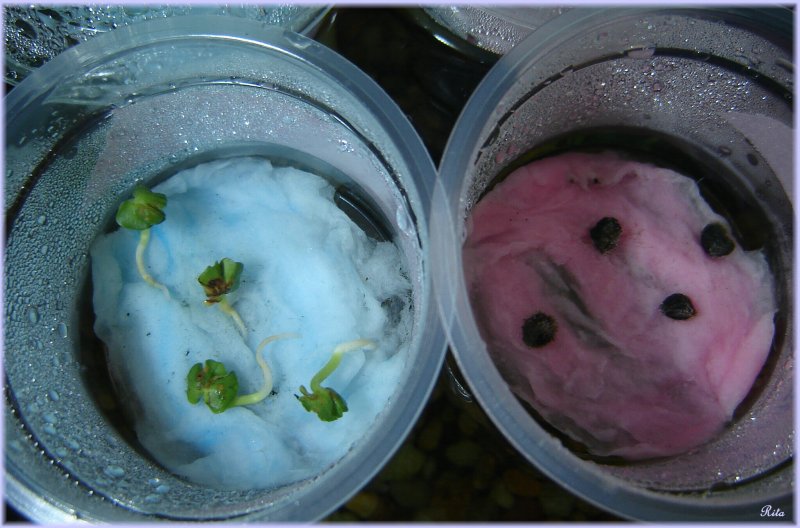
Dia 9 – Idem
Day 9 – Ditto
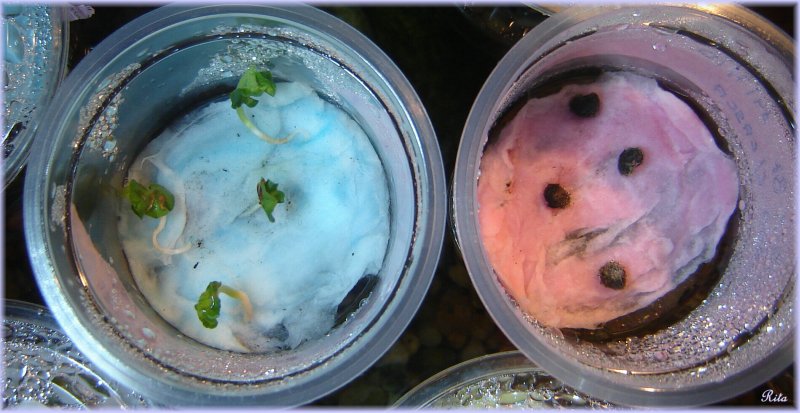
Dia 10 – Na direita, uma das sementes com casca começa a germinar.
Fui eu que quebrei a plântula do algodão azul porque
peguei com os dedos com muita força para tentar melhorar a
posição dela no algodão. Deveria ter usado uma
pinça.
Day 10 - On the right side, one of the shelled seeds start to germinate.
It was I who broke the seedling on the blue cotton because I got my
fingers very hard to try to improve it position in the cotton. I should
have used a pincers.
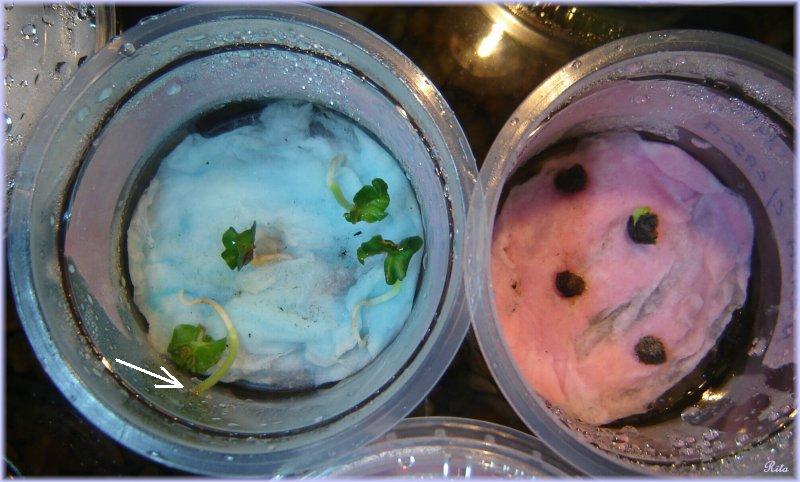
Dia
11 – A plântula do algodão rosa continua tentando
sair da casca. A mancha amarelada em volta de uma das sementes com
casca já é uma indicação de que aquela
semente não vai adiante. Se a casca tivesse sido removida desta
semente, com certeza seria percebido que a semente não estava
boa.
Day 11 - The seedling on the pink cotton is still trying to get
out. The yellow stain around one of the seed with shell is already an
indication that this seed does not go ahead. If the shell had been
removed of this seed, it would certainly be noticed that the seed was
not good.
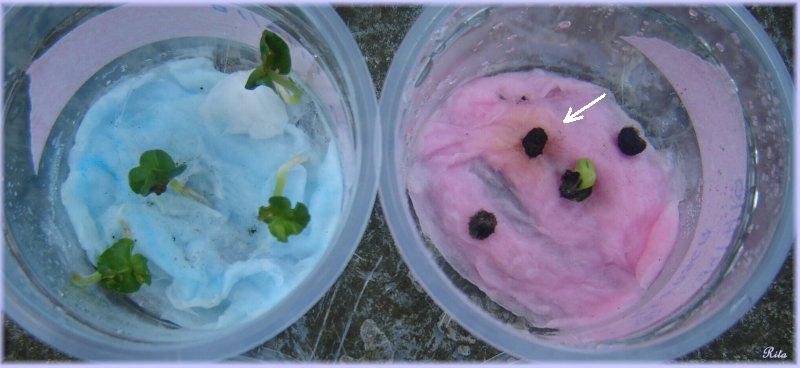
Dia 12 – Outra semente com casca começa a germinar.
Day 12 - Another seed with seed coat begins to germinate.
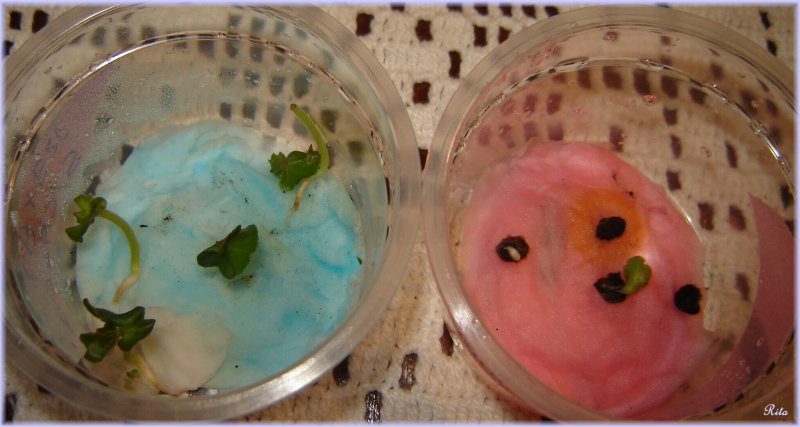
Dia 13 – As sementes saem da cidade e vão passear na chácara.
A mancha amarela da semente que está estragada no algodão
rosa fica agora evidente. Observem que uma das plântulas
conseguiu sair da casca pela parte de cima (das “folhas”) e
a outra está tentando sair pela parte de baixo, da raiz. As
Plântulas do algodão azul continuam se desenvolvendo.
Day 13 - The seeds come out of the city and go “walking” on the yard of the country house.
The yellow smudge of seed that is spoiled on the pink cotton now is
evident. Note that a seedling got out of the seed coat by the top (of the
"leaves") and the other is trying to get out by underneath, by the
root. The seedlings on the blue cotton continue to develop.
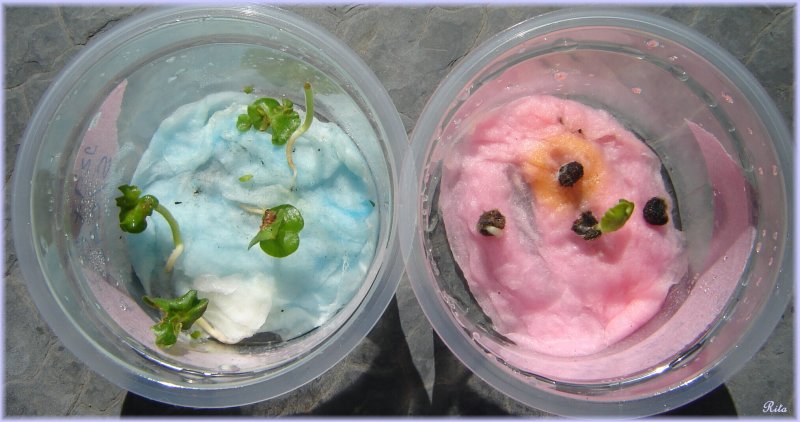
Dia
14 – As sementes retornam para a cidade e voltam para o
aquário que tem água com a temperatura controlada.
Day 14 – The seeds return to the town and go back to the aquarium that has water with controlled temperature.
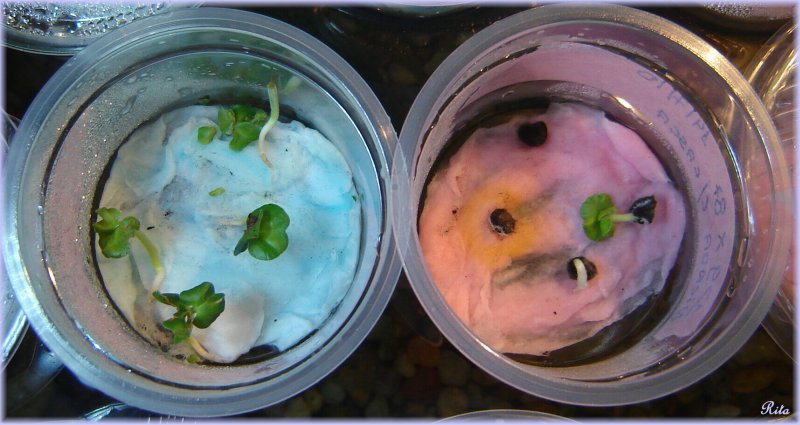
Dia 15 – A terceira semente do algodão rosa começa a germinar.
Day 15 - The third seed on the pink cotton begins to germinate.
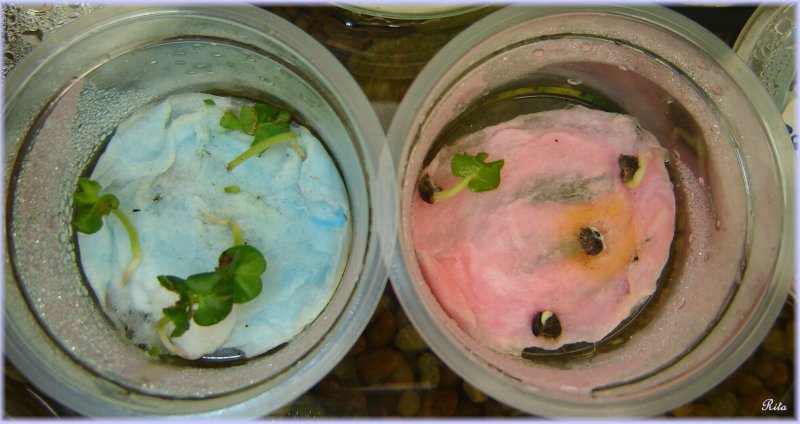
Dia 16 – A plântula da terceira semente do algodão rosa está tentando sair da casca.
Day 16 - The third seedling on the pink cotton is trying to get out from the seed coat.
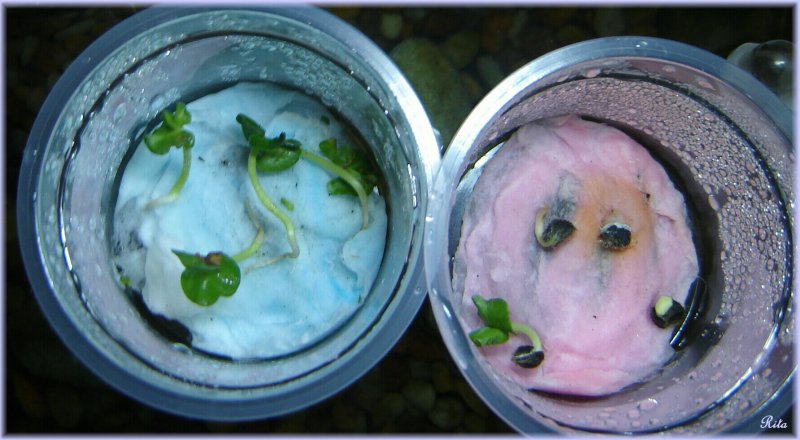
Dia
17 – As três plântulas do algodão rosa
continuam lutando para sair da casca. A plântula que já
está bem maior ainda está com a raiz presa na casca.
Day 17 - The three seedlings on the pink cotton are still
struggling to get out of the seed coat. The bigger seedling still
with the root stuck in the seed coat.
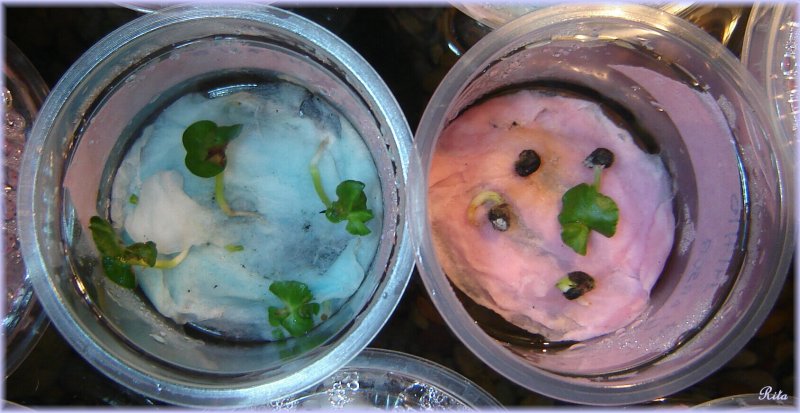
Dia 18 – A raiz da plântula maior do algodão rosa que começa a aparecer.
Day 18 - The root of the greatest seedling on the pink cotton begins to appear.
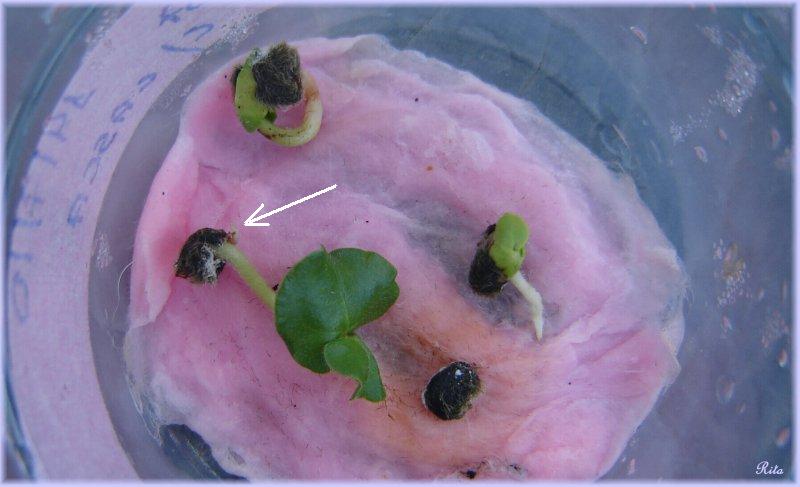
Dia
19 – Para não comprometer (secar) as raízes, as
quatro mudinhas do cruzamento 128 Key West x 87 Silver Moon que estavam
no algodão azul foram plantadas em vasos com terra.
Day 19 - To not dry the roots, the four seedlings from the cross
128 Key West x 87 Silver Moon that were on the blue cotton were planted
in pots with earth.
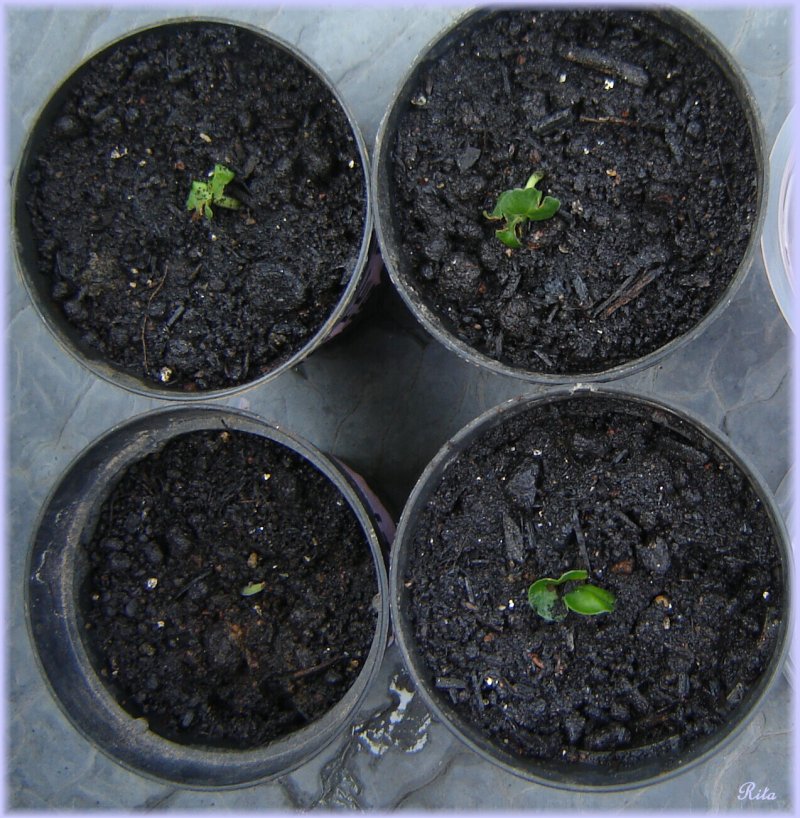
Dia 19 – As três plântulas do algodão rosa continuam tentando se livrar da casca.
Day 19 - The three seedlings on the pink cotton are still trying to get rid of the seed coat.
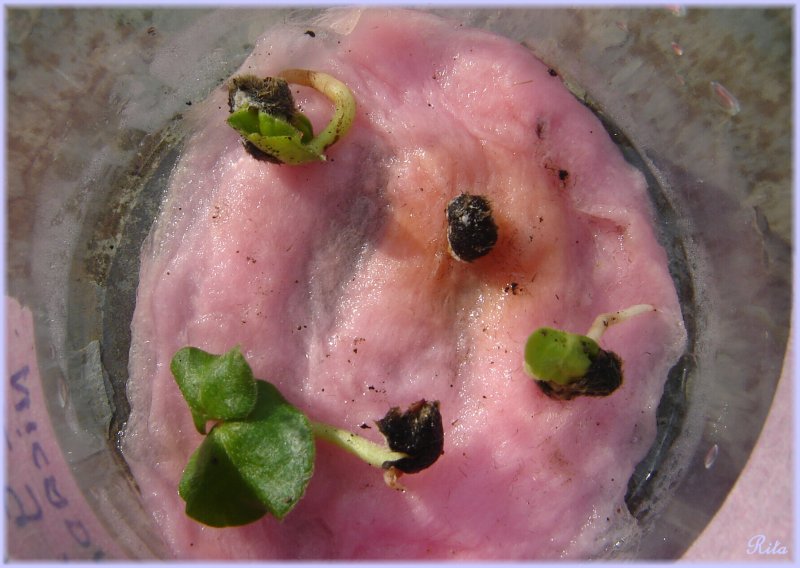
Dia
20 – Uma das plântulas consegue se livrar da casca, mas
já se observa que a raiz está comprometida (seccionada).
Day 20 - One of the seedlings get rid of the seed coat, but we can see that the root is committed (sectioned).
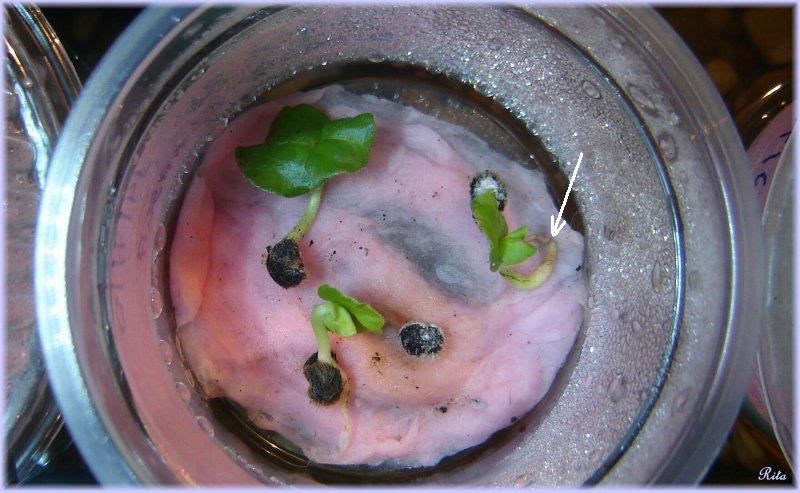
Dia
21 – Só uma das plântulas que está se
desenvolvendo perfeita tanto na parte das “folhas” como na
parte da raiz; outra ainda está com a raiz presa e a terceira
perde a ponta da raiz.
Day 21 – Only one seedling which is developing perfect,
"leaves" and root, the other is still with the root stuck and the third
lost the tip of the root.
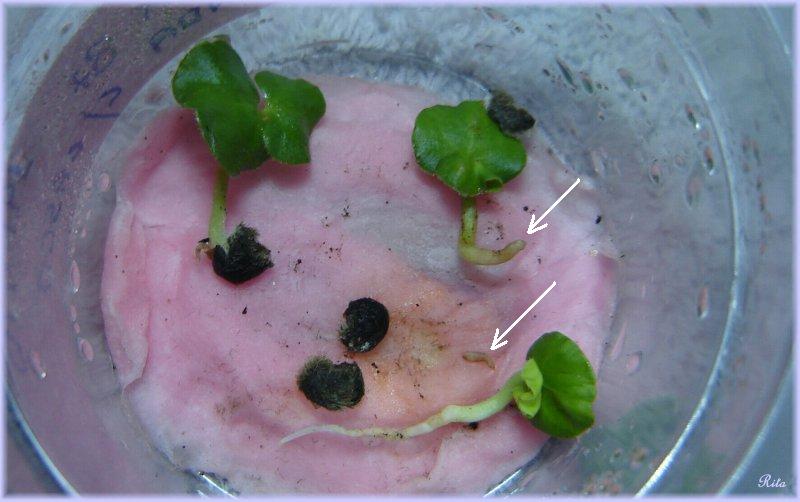
Day 22 - Permanece a mesma situação anterior.
Day 22 - Stays the same previous situation.
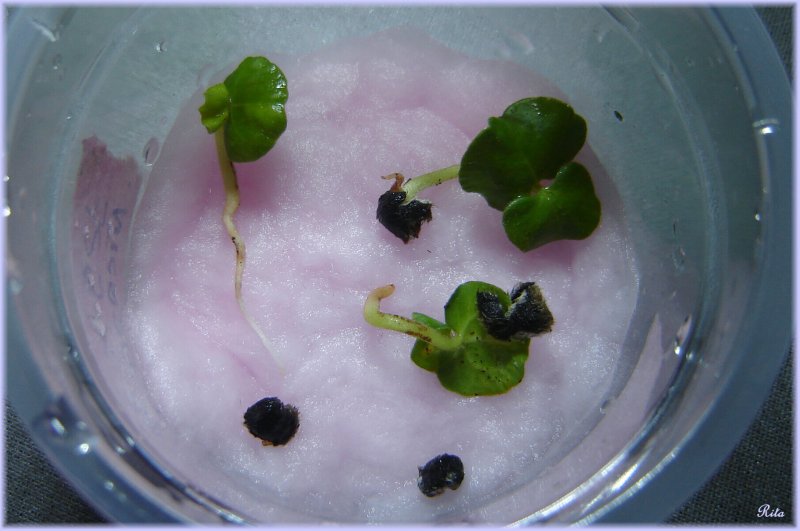
Day 23 - Permanece a mesma situação anterior.
Day 23 - Stays the same previous situation.
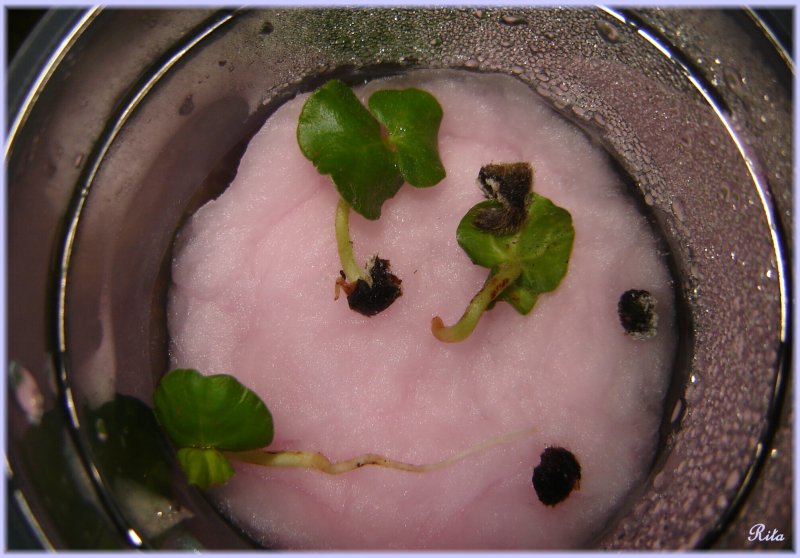
Day 24 - Permanece a mesma situação anterior.
Day 24 - Stays the same previous situation.
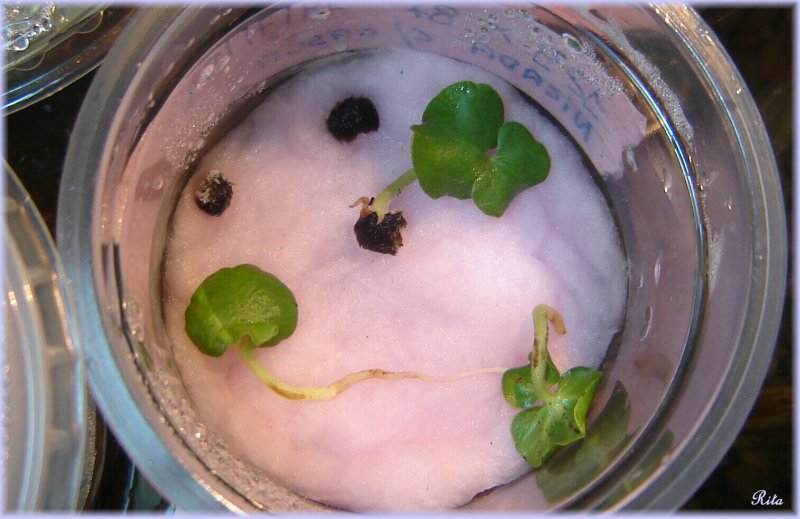
Day 25 - Permanece a mesma situação anterior.
Day 25 - Stays the same previous situation.
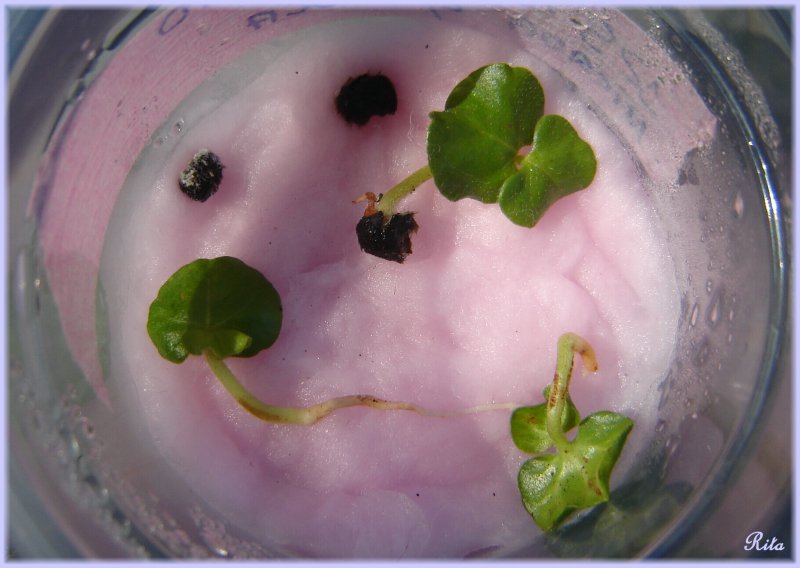
Ainda
no Dia 25, eu não resisti e ajudei a plântula a se livrar da
casca. Atrapalhei o andamento da experiência. Podemos agora ver
que tinham outras três pontas de raízes tentando encontrar
um caminho para sair da casca, mas estas raízes estão
atrofiadas.
Even on Day 25, I did not resist, and I helped the seedling to
get rid from the seed coat. I disturbed the progress of the experiment. We
can now see that others three root tips was trying to find a way out of
the seed coat, but these roots are stunted.
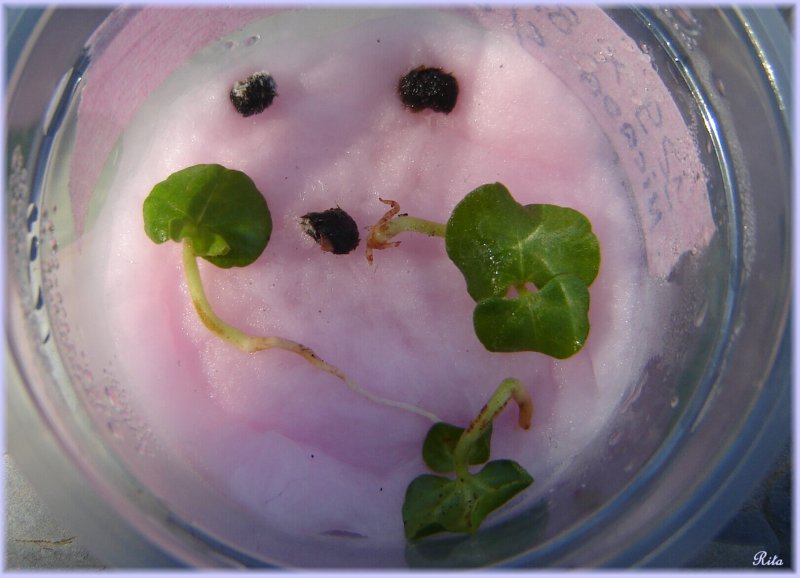
Dia
26 – As mudinhas do cruzamento 128 Key West x 87 Silver Moon que
estavam no algodão rosa foram plantadas em vasos com terra.
Day 26 - The seedlings from the cross 128 Key West x 87 Silver
Moon that were in the pink cotton were planted in pots with earth.
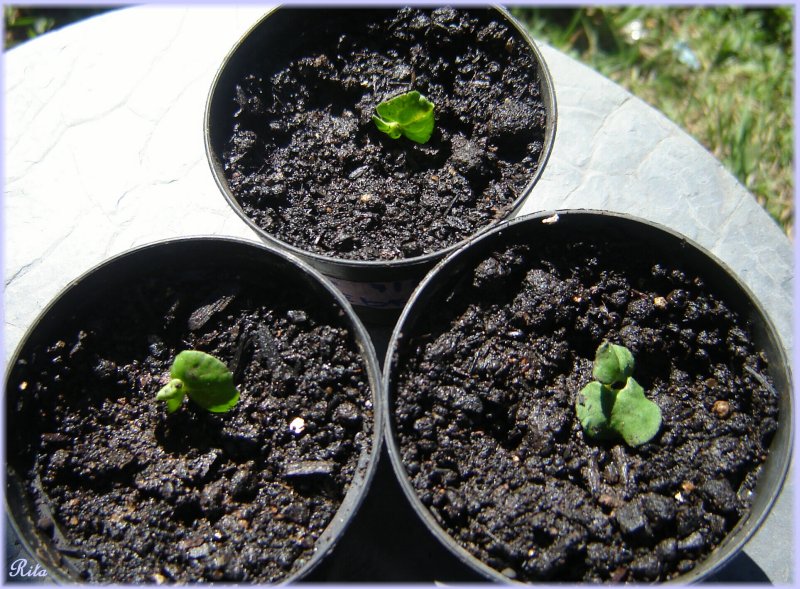
CONCLUSÃO:
Para este lote de oito sementes, das quatro sementes que foram
removidas as cascas após o primeiro dia, três sobreviveram
(a quarta eu estraguei).
E das quatro sementes que ficaram com a casca, somente uma sobreviveu.
Uma nem germinou e as outras duas não foram adiante
provavelmente porque as raízes estavam deficientes.
Com outro lote de sementes o resultado poderia ser diferente, mas para
este caso, em resumo, tivemos 75% de sucesso com as sementes onde as
cascas foram removidas e 25% de sucesso com as sementes que não
removemos as cascas.
CONCLUSION:
For this batch of eight seeds, of the four seeds that the seed coat was
removed after the first day, three survived (I screwed the fourth).
And of the four seeds that have stuck with the seed coat, only one
survived. One did not germinate, and the other two have gone nowhere
because the roots probably were with problems.
With another batch of seeds the outcome could be different, but in this
case, in short, we had 75% success with the seeds where the seed coats were
removed and 25% success with the seeds that I do not remove the seed coats.
Abraços
para todos,
All
the best for all,
Rita e Izzo
20110227
São
Paulo, 23ºC (73
ºF) - Brasil
http://www.izzobr.com/hibiscos
Fev
2011 >



























